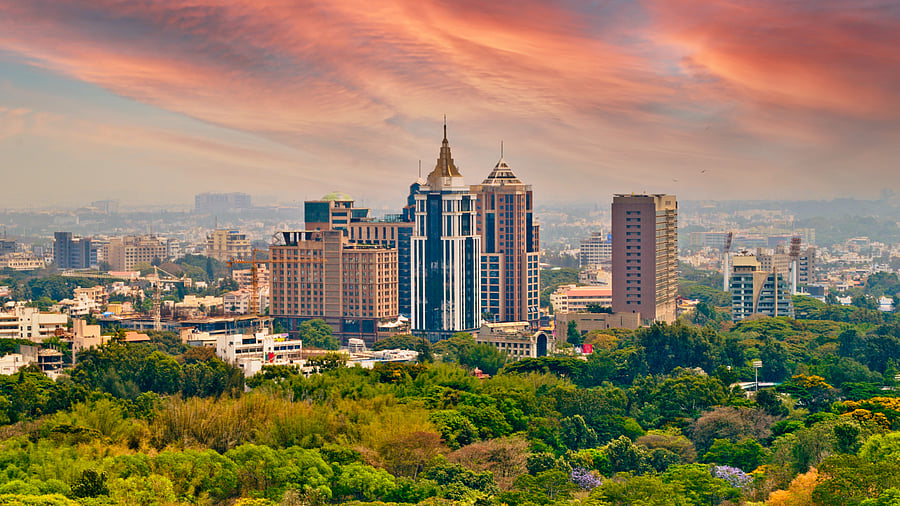
Representative image of Bengaluru.
Credit: iStock
South India is not just a cultural treasure trove – it is fast becoming a strategic engine of India’s creative economy. The recently concluded 11-day Mysuru Dasara festival offered more than a dazzling display of heritage and celebration; it was a vivid reminder of how creativity fuels commerce, livelihoods, and regional growth.
Under the glow of the illuminated Mysuru Palace, the festival drew thousands of visitors from across India and abroad. The Mysuru Zoo alone welcomed over 1.5 lakh visitors, generating nearly Rs 2 crore in revenue. Hotels across the city reported turnovers exceeding Rs 100 crore in under two weeks. The Dasara Book Festival recorded Rs 96 lakh in sales, while Dharwad’s Nandini unit sold a record 19 tonnes of sweets. The palace itself saw over one lakh tourists. These figures underscore a powerful truth: culture is not just an expression of identity – it is a driver of economic dynamism, entrepreneurship and job creation.
Festivals such as Mysuru Dasara reflect the creative tide transforming India’s economy. Across South India, celebrations like the Margazhi Music and Dance Festival in Chennai, Thrissur Pooram in Kerala, Bonalu in Telangana, and Karaga in Bengaluru are vital to creative entrepreneurship. They act as living laboratories, showing how tradition can be reimagined through technology, storytelling and design to create scalable value. From the global reach of Carnatic music via streaming platforms to AR/VR-enabled temple experiences, South India demonstrates how cultural heritage can be a launchpad for future-ready creative industries. They bring together artisans, performers, designers, and digital creators, generating employment and tourism.
India’s creative economy is driving new forms of work and growth. It now features prominently in global conversations – from G20 deliberations to UNESCO and UNCTAD forums – where culture and commerce increasingly intersect. Globally, creative industries are growing 15% faster than traditional sectors, forming a market worth over $1.6 trillion. India’s creative sector is valued at nearly $30 billion, employing 8% of the workforce and generating over $11 billion in creative exports. With 2-2.5 million monetised creators influencing $350–400 billion in consumer spending, the sector could drive over $1 trillion in creator-led consumption by 2030.
South India – led by Bengaluru, Chennai, Hyderabad, and Thiruvananthapuram – is emerging as the creative heart of the nation. Bengaluru is evolving into a gaming and design hub, leveraging its tech talent and startup ecosystem. Hyderabad has become India’s film capital, home to the world’s largest studio complex – Ramoji Film City – and cutting-edge production houses. Chennai and Thiruvananthapuram nurture talent in performing arts, music, and animation. This growth reflects strategic investments, policy support, and international collaboration.
State-led initiatives and institutional partnerships are laying the foundation for a resilient creative economy. The All-India Initiative on Creative Economy, along with collaborations in AVGC (Animation, Visual Effects, Gaming, Comics), crafts, festivals, and music, is catalysing talent development and global engagement, while Tamil Nadu’s MGR Film and Television Institute is modernising training. The British Council–Guidance Tamil Nadu MoU strengthens the state’s creative industries. In Kerala, the British Council’s partnership with the Startup Mission supports creative entrepreneurs. The upcoming National Centre of Excellence for AVGC-XR will help build future-ready skills.
International education and collaboration are critical to building sustainable creative ecosystems. Scholarships at leading UK universities, knowledge exchanges, and cross-border programmes are preparing a new generation of globally competitive creators. Programmes like the GREAT Campaign and Scholars for Outstanding Undergraduate Talent (SCOUT) enable students from Telangana, Tamil Nadu and Karnataka to pursue international learning that merges creativity with employability.
The story of V Kavya, the daughter of a daily wage worker from Telangana who earned a place at the University of Glasgow, exemplifies how global education transforms lives. The Karnataka State Higher Education Council (KSHEC) selected 30 students from six universities for a two-week immersion at the University of East London. Students from across Tamil Nadu explored data science and AI at Durham University. These initiatives represent strategic investment in human capital, equipping young minds with skills and global connections to lead India’s creative and knowledge economies.
South India’s creative energy is gaining global traction through platforms that connect artists, entrepreneurs, and institutions. The Festivals from India, platform dedicated to showcasing thousands of art and culture festivals, amplifies the Hyderabad Literary Festival, Bengaluru by Design, International Theatre Festival of Kerala, and Hyderabad Design Week. The UK–India Programme of Cultural Cooperation and the British Council’s Creative Convergence in Bengaluru are convening cultural leaders, policymakers, and changemakers to co-create future-ready ecosystems. These dialogues help shape policy, foster innovation, and build sustainable creative infrastructure.
South India is not merely participating in the global creative economy – it is poised to define it. With its blend of culture, innovation, and entrepreneurship, the region is setting the stage for a new economic narrative – one where creativity is not
just celebrated, but strategically harnessed for impact.
(The writer is the director -South India at the British Council, where she leads initiatives that strengthen India–UK partnerships, in arts, education, and the creative economy)
Disclaimer: The views expressed above are the author's own. They do not necessarily reflect the views of DH.